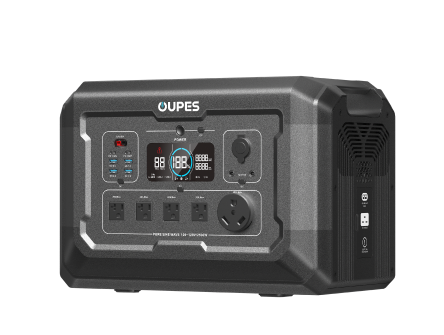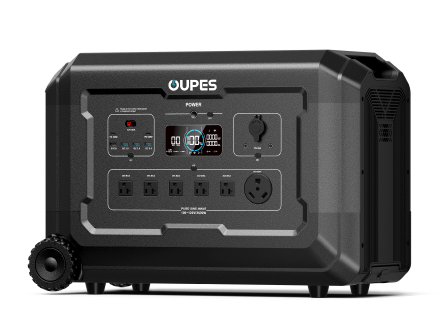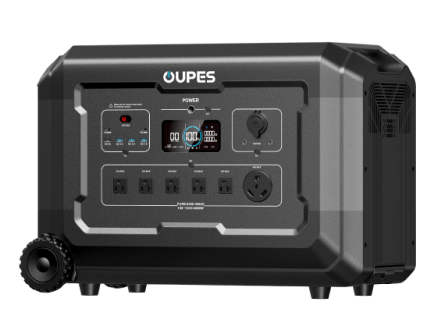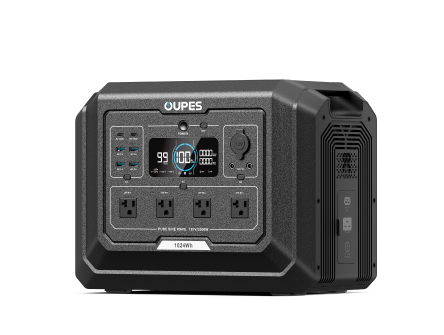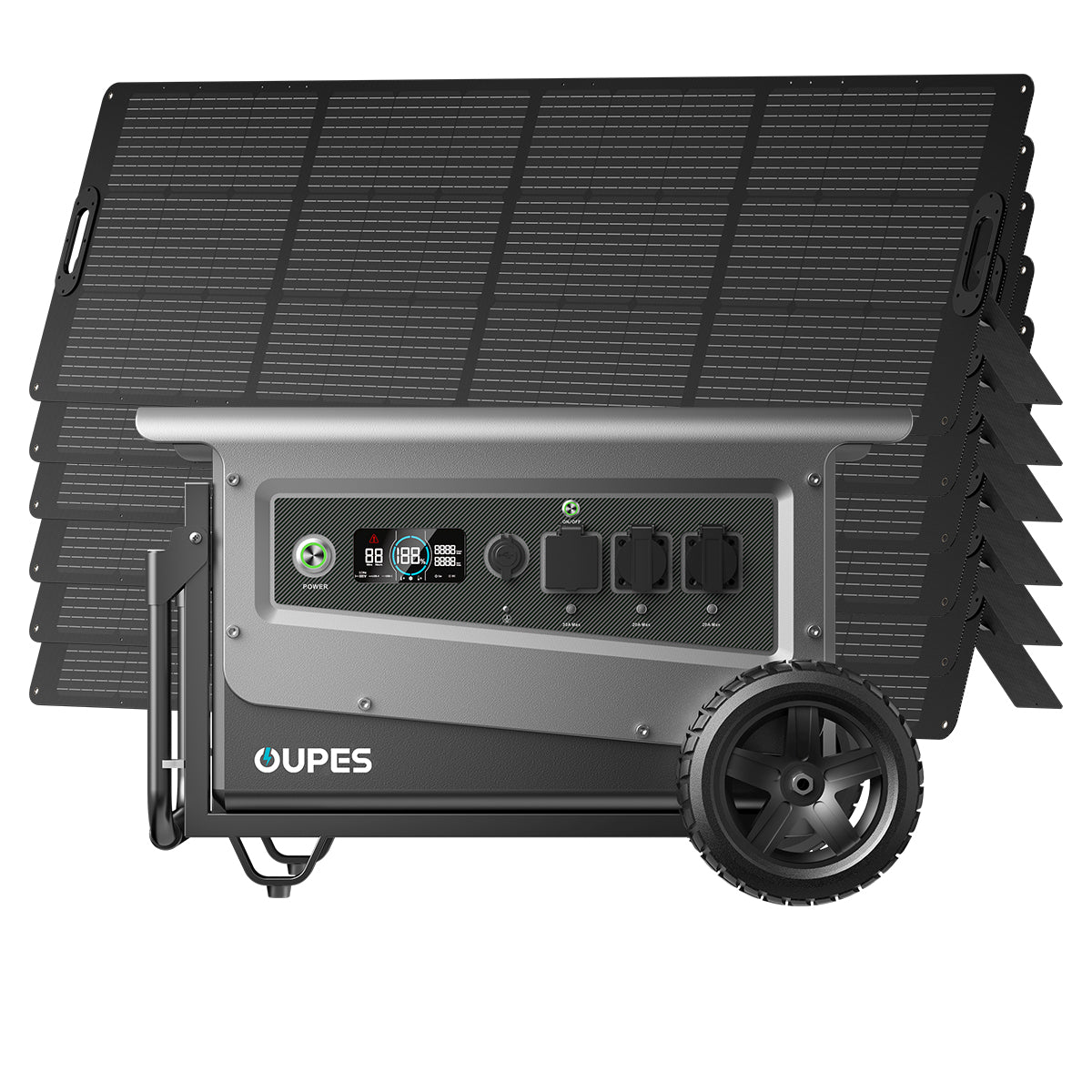
Wind howls, the sky turns a deep slate, and the first droplets lash the windows. Within minutes, a familiar hum fades—the grid has gone down across the neighborhood. In that instant you realize that light, communication, refrigeration, and even medical devices depend on a power source that’s suddenly vanished. Portable solar panels transform that moment of uncertainty into one of control, giving you a safe, renewable way to keep essentials running during and after a hurricane.
Unlike fuel-based backups that demand risky refueling and outdoor operation, compact solar panels fold into a go-bag, deploy quickly when the clouds break, and feed energy into a battery power station you can operate indoors. This guide explains why portable solar is one of the safest choices for storm preparedness, how to size and set up a kit, and how to get the most runtime from every ray of post‑storm daylight—especially when paired with a reliable OUPES portable power station.
Why Portable Solar Panels Are a Safer Choice When the Winds Rise
Safety is the first, second, and third priority in a hurricane. Traditional generators introduce hazards at exactly the wrong moment: carbon monoxide from exhaust can accumulate invisibly, gasoline must be stored and poured under duress, and engines vibrate and spark near wind-blown debris. Portable solar panels eliminate these vectors. They generate no fumes, require no flammable fuel, and have no hot exhaust or moving parts. The panel sits quietly in a sunny spot while the battery system it feeds remains indoors, powering your lights, radios, and critical devices with zero on-site emissions.
Carbon monoxide poisoning surges after storms precisely because families are desperate for power and bring combustion devices too close to living spaces. Solar sidesteps that risk. A collapsible array paired with a battery power station delivers AC and DC output safely inside—supporting CPAP machines, charging phones, running LED lighting, and keeping a compact refrigerator cycling without cracking a window or propping a door. The same safety advantage extends to weather exposure. Refueling a hot generator in gusting rain is dangerous; positioning a weather-resistant panel after the worst has passed is simple. When lightning threatens, you can disconnect and store the panel in seconds without dealing with combustible liquid or a heavy engine.
Noise is another health factor during emergencies. Hours of engine roar stress pets, children, and anxious neighbors—and broadcast that your home has power. Portable solar solutions operate in near silence. That low profile reduces tension and helps you rest, which is essential for decision-making and recovery. Finally, in flood-susceptible areas, the ability to elevate both the panel and the power station above water level is far easier than safeguarding a fuel tank and combustion engine. With no oil, fuel, or exhaust, cleanup is simpler too, should the unit encounter spray or debris.
How Portable Solar Panels and Power Stations Work Together to Keep Essentials Running
Portable solar panels are only half of the solution; the other half is energy storage. Think of the panel as a faucet and the battery power station as a reservoir. When sunlight returns—even weakly through scattered cloud—the panel’s photovoltaic cells convert photons to DC electricity. A charge controller (ideally MPPT for efficiency) maximizes harvest from variable light and feeds a safe, regulated stream into your battery. The power station’s inverter then turns stored DC into pure sine wave AC for household devices, while DC and USB ports provide direct, efficient charging for phones, radios, and LED lighting.
Pre-charging is your first line of defense. In the days or hours before landfall, top off the power station from wall AC so you begin the event with a full battery. Once winds subside to safe levels and rains ease, deploy your portable panel to replenish that reservoir. Even on overcast days, modern panels capture diffuse light; while the harvest is reduced, steady trickle charging throughout daylight hours can extend total runtime significantly. Systems like OUPES power stations display real-time input and output, helping you decide which loads to prioritize and when to pause a device to bank energy for nighttime essentials.
Device selection matters. Refrigerators cycle, drawing more power only when compressors run, while LED lighting consumes very little. Charging phones and power banks is highly efficient through USB-C PD ports, preserving battery state better than running wall chargers. Many battery systems allow “pass-through” operation, meaning you can charge the power station from solar while simultaneously running devices—useful when midday sun is strongest. For larger loads you might schedule usage: blend a smoothie or heat a quick meal when your panel is producing most and let the battery handle overnight communications and medical equipment. With thoughtful sequencing, a modest panel array can stretch a limited battery far longer than you might expect.
Choosing Hurricane-Ready Portable Panels: What Really Matters When the Grid Is Down
Not all panels perform equally after a storm. Focus on practical attributes that impact real-world safety and performance. First, ruggedness. A hurricane brings salt spray, grit, and debris. Look for panels with durable fabrics or frames, reinforced corners, and water-resistant junction boxes. Stitching, hinges, and handle design matter for repeated deployments. A folding, briefcase-style panel slips into a closet before the storm and sets up quickly in a small yard or on a balcony afterwards.
Second, conversion efficiency and total wattage. Higher-efficiency cells mean more power from the same footprint—crucial when the only safe sunlight is a small patch of driveway or a balcony corner. Wattage determines how quickly you can refill your battery reservoir. A 200W panel in bright sun might deliver around 150–180W of net charging after controller and cable losses; over five hours of decent light that’s roughly 0.8–0.9 kWh of energy back into storage. Scale panel size to your battery and your essential loads. If your must-run list includes a compact fridge, Wi‑Fi router, phone charging, and a CPAP, consider at least 200–400W of panels to hedge against clouds and short winter days.
Third, connection and controller compatibility. Panels that terminate in standard connectors and include MC4-to-barrel or MC4-to-APP adapters reduce friction during stressful moments. Confirm that your power station supports MPPT and that the panel voltage and current fall within its safe input window. OUPES power stations pair cleanly with a range of portable panels, and their MPPT controllers squeeze more energy from variable post‑storm light, improving day-to-day viability when the grid stays down longer than expected.
Finally, portability and stowability. A panel you can carry in one hand encourages quick deployment during short sun breaks. Panels that fold flat store easily under a bed or on a shelf and can be evacuated with you if authorities issue a sudden order. Remember that every minute of sunlight harvested is minutes of nighttime safety later—gear that deploys in under a minute will capture more energy across an unpredictable week.
Smart Operating Practices: Squeezing Maximum Runtime from Every Patch of Sunlight
The storm may pass, but clouds, debris shadows, and limited safe outdoor access can persist for days. Operating strategy becomes as important as hardware. Start with load triage. Define “life and safety” loads—medical devices, lighting for night movement, charge for communications—then “comfort and continuity” loads—fans, refrigeration, and limited cooking. The goal is to keep life-and-safety loads on continuously and batch comfort tasks during peak sun. If your fridge holds temperature well, open it sparingly and run it in discrete windows when solar input is highest. Many modern fridges can maintain safe temperatures with periodic runtime if doors remain closed.
Panel placement is dynamic in a post‑hurricane environment. The sun’s path may be partially blocked by fallen limbs or neighboring structures. Rather than “set and forget,” check shadows hourly and shift the panel as safe to chase clear patches of sky. Tilt improves output; a makeshift stand fashioned from intact furniture or a railing offers a safe angle without permanent mounts. Keep cables off wet ground where possible and route them to avoid trip hazards in crowded shelter areas. If the panel surface is dirtied by salt spray or debris, a quick wipe with a soft cloth can immediately restore wattage otherwise lost to grime.
Energy hygiene extends to device behavior. Reduce screen brightness, engage airplane mode when not communicating, and prefer DC charging over AC bricks to eliminate inverter losses. Where possible, charge small power banks during the day and use them to top off phones overnight, keeping the main power station focused on mission-critical loads. If your system supports app monitoring—as with many OUPES units—watch input/output graphs to learn your home’s energy rhythm and refine when to run which devices. Small refinements compound into hours of added runtime across a multi‑day outage.
Building a Hurricane Kit Around Portable Solar and an OUPES Power Station
A solar‑first hurricane kit centers on three pillars: stored energy, generation, and sensible consumption. Begin with a right‑sized battery power station as your dependable reservoir. OUPES units with LiFePO₄ batteries deliver excellent cycle life and thermal stability—important when ambient temperatures swing and charging sessions happen in short bursts between rain bands. Their pure sine wave output protects sensitive medical gear and electronics, while clear displays and optional app control reduce guesswork under stress.
Pair the power station with a portable panel set scaled to your household’s priorities. If you anticipate running a compact fridge, router, and medical device, two foldable panels totaling 200–400W provide a realistic daytime harvest even under thin cloud. Stow a full set of compatible cables and adapters in a labeled pouch so anyone in the family can deploy quickly. Before the season, practice the whole flow: pre‑charge from the wall, deploy panels, watch the MPPT lock on, plug in each essential device, and simulate a 24‑hour outage. Familiarity now prevents mistakes later.
Round out the kit with LED lanterns, a battery radio, spare phone cables, and a soft cloth for panel cleaning. Choose a dry, elevated storage spot that’s accessible in the dark. When a watch is announced, fully charge the station, top off phone power banks, and review your priority loads. During the event, keep the station elevated off potential flood paths, and reposition panels only when winds subside to safe levels. Afterward, reassess daily: are clouds heavier today? Shift more tasks to midday. Do you have extra harvest? Add a comfort load, like a short fan session, to improve rest and recovery.
Most importantly, treat the system as a year‑round tool, not a single‑purpose purchase. Use the panel and power station for camping, backyard projects, or off‑grid workdays. Regular use keeps batteries healthy and ensures you remain fluent in setup and optimization. When the next advisory hits, you’ll be confident, practiced, and ready to convert hours of daylight into safe, quiet nighttime power.
Portable solar panels change the hurricane calculus. Instead of choosing between unsafe exhaust or total darkness, you can safely produce energy wherever the sun finds you—even in narrow breaks between bands of cloud. By pairing compact, durable panels with a capable OUPES portable power station, you secure a silent, emission‑free lifeline that starts full before landfall and refills each day afterward.
Preparation is power. With a thoughtful kit, practiced deployment, and smart energy habits, portable solar can keep your lights on, your food safe, your communications alive, and your loved ones secure while crews restore the grid. The storm will pass; your plan ensures safety until it does.

